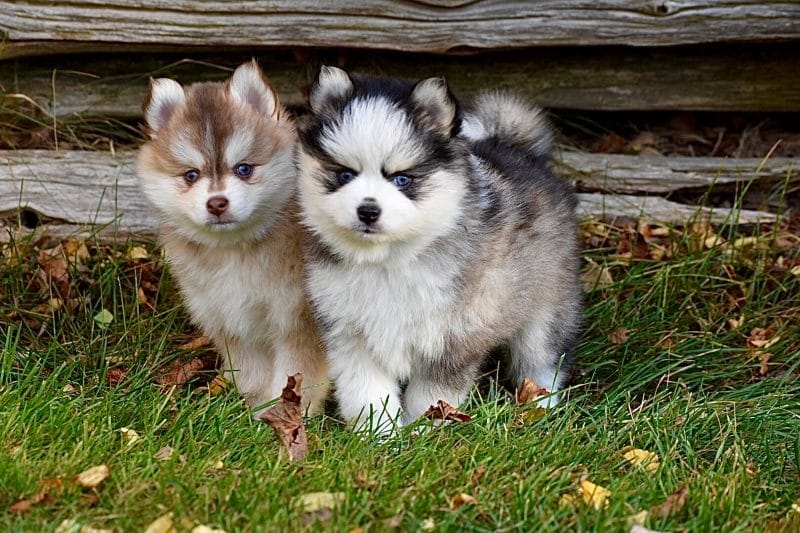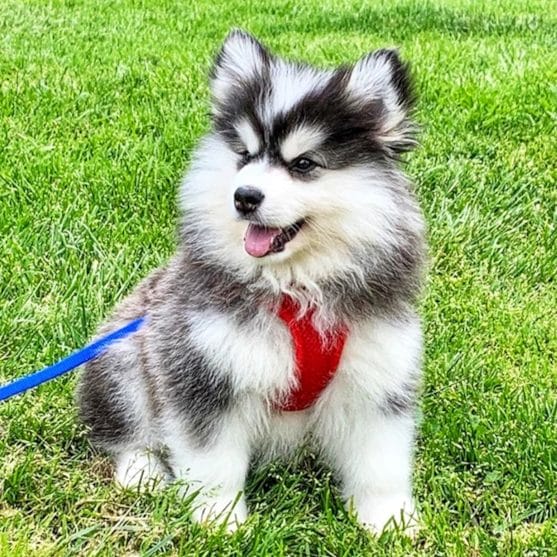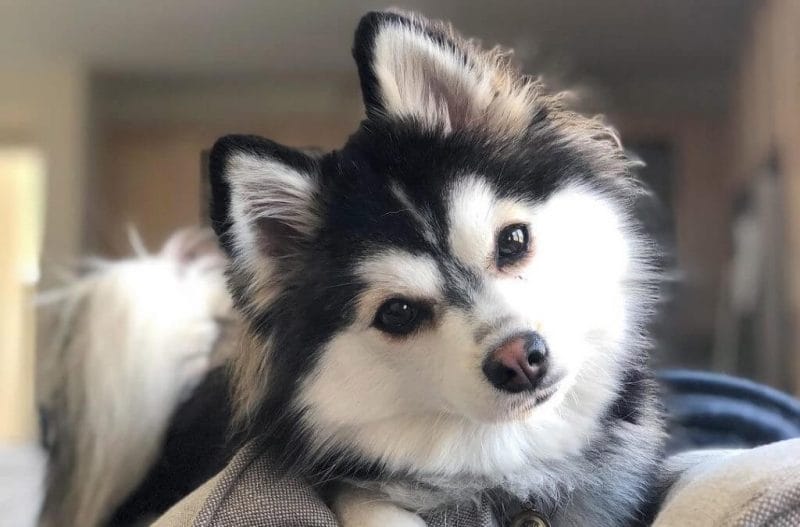Pomskies, the delightful crossbreed between Siberian Huskies and Pomeranians, have captured the hearts of dog lovers around the world. These pint-sized pups combine the spirited nature of Huskies with the adorable charm of Pomeranians, resulting in a unique and lovable companion. In this extensive guide, we will delve into the origins, characteristics, care, and all aspects to help you better understand and appreciate this enchanting breed.
Introduction
The Pomsky is a relatively new designer breed that emerged in the late 20th century. This hybrid originated from the desire to create a smaller version of the Siberian Husky while maintaining its striking appearance. Here is an overview of Pomskies:
- Origins: Pomskies are a cross between Siberian Huskies and Pomeranians. Breeders aim to combine the Husky’s majestic appearance with the Pomeranian’s petite size.
- General Information: Pomskies are small to medium-sized dogs known for their striking blue eyes, fluffy double coat, and spirited personalities. They inherit traits from both parent breeds, making each Pomsky unique in appearance and temperament.
Adaptability: ★★★★☆
All-around Friendliness: ★★★★☆
Affectionate With Family: ★★★★☆
Kid-Friendly: ★★★☆☆
Dog Friendly: ★★★☆☆
Friendly Toward Strangers: ★★★☆☆
Health And Grooming Needs: ★★★☆☆
Amount Of Shedding: ★★★★☆
Drooling Potential: ★★☆☆☆
Easy To Groom: ★★★☆☆
General Health: ★★★☆☆
Potential For Weight Gain: ★★★☆☆
Size: ★★★☆☆
Trainability: ★★★☆☆
Easy To Train: ★★★☆☆
Intelligence: ★★★☆☆
Potential For Mouthiness: ★★☆☆☆
Prey Drive: ★★★☆☆
Tendency To Bark Or Howl: ★★★☆☆
Wanderlust Potential: ★★★☆☆
Exercise Needs: ★★★☆☆
Energy Level: ★★★☆☆
Intensity: ★★★☆☆
Exercise Needs: ★★★☆☆
Potential For Playfulness: ★★★★☆
Pomsky – Breed Overview
- Appearance: Pomskies can have a range of appearances, but they often inherit the Husky’s striking blue eyes, erect ears, and fluffy coat. Their size can vary depending on the percentage of each parent breed in their lineage.
- Characteristics: Pomskies are known for their spirited and playful nature. They are social dogs that thrive on interaction with their families.
- Popularity: The Pomsky has gained popularity in recent years due to its adorable appearance and charming personality. It is considered one of the sought-after designer breeds.
- Temperament: Pomskies are typically affectionate, alert, and lively. They enjoy being the center of attention and may display some stubbornness at times.
- Lifespan: The average lifespan of a Pomsky ranges from 12 to 15 years when well cared for.
- Coat Color: Pomskies come in various coat colors and patterns, including red, black, gray, and cream.

Is Pomsky a Mixed-Breed or an Original Breed?: Pomskies are considered a mixed-breed or designer breed since they are a deliberate cross between two distinct breeds, the Siberian Husky and the Pomeranian.
How to Take Care of a Pomsky
Food:
Proper nutrition is vital for your Pomsky’s health. Here are three examples of essential foods for Pomskies:
- High-Quality Dog Food: Opt for a reputable dog food brand that meets the specific nutritional needs of small to medium-sized breeds.
- Protein-Rich Diet: Pomskies benefit from a diet rich in lean protein to support their active lifestyle and maintain muscle mass.
- Small Breed Formula: Consider a small breed dog food formula designed to meet the needs of smaller dogs, including appropriate kibble size.
Environment:
Creating a suitable environment for your Pomsky is essential for their well-being. Here are three essential elements for their environment:
- Secure Fencing: Ensure you have a secure fence to prevent them from escaping, as they may have a tendency to wander.
- Indoor Play: Enjoy indoor play, so provide toys and interactive games to keep them mentally stimulated.
- Climate Control: Protect them from extreme heat or cold, as their double coat may not provide adequate insulation in extreme conditions.
Take Care Method:
Pomskies thrive on social interaction and play. Spend quality time with your Pomsky, engage in daily exercise, and provide mental stimulation through puzzle toys and training sessions.
Grooming:
Maintaining your Pomsky’s coat and hygiene is crucial. Here are some grooming recommendations:
- Brush their coat at least a few times a week to prevent matting and reduce shedding.
- Bathe your Pomsky as needed, typically every 1-2 months.
- Clean their ears regularly to prevent wax buildup and potential infections.
- Trim their nails when they become too long, usually every 4-6 weeks.

How to Prepare for a Pomsky’s Life
Three Short Advice Sentences: Be prepared for an active and playful companion. Invest in training and early socialization. Regular grooming is a must.
How to Take Care of a Pomsky: Provide a balanced diet, a secure environment, toys for mental stimulation, regular vet visits, and grooming.
List of Essential Equipment for Caring for a Pomsky:
- Leash and harness for daily walks.
- A crate for training and safe confinement.
- Interactive toys to keep them mentally stimulated.
- Common Diseases: may be prone to certain health issues, including hip dysplasia, dental problems, and skin allergies. Regular vet check-ups and a healthy diet can help prevent these issues.
- Necessary Vaccines for Pomskies: Consult with your vet, but common vaccines for Pomskies include rabies, distemper, and parvovirus vaccinations.
Common Name for Pomsky
- Choosing the perfect name for your Pomsky can be fun. Here’s some advice:
- Choose a name that suits their personality and appearance.
- Opt for shorter names that are easy to call.
Common Names for Pomskies:
- Luna
- Teddy
- Bella
- Rocky
- Daisy
- Cody
- Rosie
- Max
How to Buy/Adopt a Pomsky
If you’re considering adding a Pomsky to your family, here are some steps to follow:
- Locations of Pomsky’s Popularity: popular in various regions but are more common in areas where designer breeds are in demand.
- Average Price for a Pomsky: can be expensive, with prices ranging from $1,000 to $5,000 or more, depending on factors like lineage and breeder reputation.
- Community for Pomsky Adoption: Look for Pomsky rescue groups on social media platforms like Facebook and Instagram. Additionally, consider adopting from local animal shelters.

What to Check Before Adopting/Buying a Pomsky:
- General health: Ensure the dog is in good health by requesting a vet checkup.
- Vaccination status: Verify that the dog is up-to-date on vaccinations.
- Medical history: Ask for the dog’s medical history to be aware of any preexisting conditions.
In conclusion, Pomskies are a delightful combination of Husky and Pomeranian characteristics, offering a mix of playfulness, affection, and striking appearance. By providing them with proper care, training, and attention to their specific needs, you can enjoy a rewarding and loving relationship with your Pomsky companion.
How to Stop Pomsky Biting:
Use positive reinforcement training methods to discourage biting and provide appropriate chew toys.
How to Do Socialization and Raise a Friendly Pomsky:
Socialize your Pomsky from a young age by exposing them to various people, animals, and environments. Positive experiences during socialization will help them become friendly and well-adjusted adults.
How to Train Your Pomsky:
Respond well to positive reinforcement training methods. Consistency, patience, and rewards for good behavior are key to successful training.
How Long Should You Check for a Pomsky’s Health with a Vet?:
Regular vet checkups should occur at least once a year, but more frequent visits may be necessary as they age.
Are Pomskies Good Family Pets?:
Yes, known for their affectionate nature and can make great family pets.
Are Pomsky Dogs Good with Children?:
Pomskies can be good with children, but early socialization and supervision are essential, especially with smaller.
How to Stop Pomsky Biting:
Use positive reinforcement training methods to discourage biting and provide appropriate chew toys.
How to Do Socialization and Raise a Friendly Pomsky:
Socialize your Pomsky from a young age by exposing them to various people, animals, and environments. Positive experiences during socialization will help them become friendly and well-adjusted adults.
How to Train Your Pomsky:
Respond well to positive reinforcement training methods. Consistency, patience, and rewards for good behavior are key to successful training.
How Long Should You Check for a Pomsky’s Health with a Vet?:
Regular vet checkups should occur at least once a year for Pomskies, but more frequent visits may be necessary as they age.
Are Pomskies Good Family Pets?:
Yes, known for their affectionate nature and can make great family pets.
Are Pomsky Dogs Good with Children?:
Pomskies can be good with children, but early socialization and supervision are essential, especially with smalle.
Is a Pomsky a Smart Dog?:
moderately intelligent and can learn commands, although they may have a stubborn streak.
Temperament of Pomsky:
known for their spirited and playful temperament.
How Many Types of Pomsky?:
There are no distinct “types”, but their appearance and size can vary depending on the percentage of Husky and Pomeranian in their lineage.
How Many Colors of Pomsky?:
come in various coat colors, including red, black, gray, cream, and more.
How Long Can a Pomsky Live?:
The typical lifespan of a well-cared-for Pomsky is around 12 to 15 years.
Can Pomskies Cause Allergies?:
While no dog is entirely hypoallergenic, Pomskies tend to shed less than some other breeds, making them a better choice for allergy sufferers.
Are Pomskies Ferocious?:
No, Pomskies are generally not ferocious; they are friendly and playful.
Do Pomskies Have Hair Loss Problems?:
Pomskies do shed, especially their thick double coat, so regular grooming is necessary to manage shedding.
More information about Dog Breeds & Dog Care follow Dog Care Tips site.

